BACK TO HOME PAGE
COUNTERFEIT FRACTIONAL CURRENCY
COUNTERFEIT FRACTIONAL CURRENCY
Counterfeiting notes has been a problem in this country starting in the revolutionary times. Copies of early parchment notes were made by some unscrupulous printers. This forced the government to embed mica chips into the parchment to make it harder to duplicate the paper used in the printing process of the early script. With fractional currency, the production of all five different issues and all their varieties were done to try to thwart the production of spurious notes. As fast as the government printing came up with a solution, counterfeiters were already making and passing new counterfeit currency.
First Issue CFT's
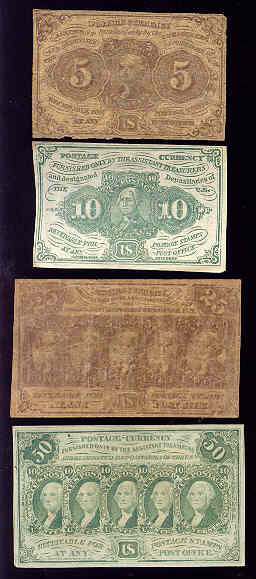 All four denominations of the first issue postage currency were counterfeited. The paper used for the counterfeit notes appears to be thinner than the genuine notes. They had problems duplicating the reverse of these notes. The oval border surrounding the inscriptions in the genuine notes should have a series of distinct white dots in the center of the band. It should be so obvious to catch your eye. In the counterfeit, the band is dark and does not show the series of white dots. The portraits on the obverse of the spurious notes only crudely resemble their intended President. To help cover up the poor engravings of the portraits of some of the 25C notes, wax paper was placed over the obverse of the freshly inked paper to mute the engravings. The notes were also wrinkled and washed to make the note to appear to have been in circulation. Shown to the left are counterfeit examples of each of the denominations in the first issue. Please note the crude faces on each of the notes.
All four denominations of the first issue postage currency were counterfeited. The paper used for the counterfeit notes appears to be thinner than the genuine notes. They had problems duplicating the reverse of these notes. The oval border surrounding the inscriptions in the genuine notes should have a series of distinct white dots in the center of the band. It should be so obvious to catch your eye. In the counterfeit, the band is dark and does not show the series of white dots. The portraits on the obverse of the spurious notes only crudely resemble their intended President. To help cover up the poor engravings of the portraits of some of the 25C notes, wax paper was placed over the obverse of the freshly inked paper to mute the engravings. The notes were also wrinkled and washed to make the note to appear to have been in circulation. Shown to the left are counterfeit examples of each of the denominations in the first issue. Please note the crude faces on each of the notes.
There has been only one variety for the 5C first issue counterfeit identified. It is extremely rare type with only three known examples.
The 10C note has at least five different varieties. Look at the crude engraving of Washington.
For the 25C notes, there are at least nine different types of counterfeits. With the note shown, you can see the result of using wax paper to mute the facial engravings.
The most copied note was the fifty cent denomination with at least twenty different counterfeit varieties. The counterfeiters were going to make more by counterfeiting the higher value note.
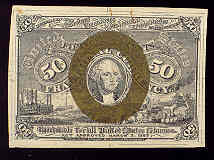
Second Issue CFT's
Because there were so many different varieties of counterfeits for the first issue, the treasury department decided to experiment with the use of different paper for the notes in the second issue to make it harder to duplicate. The second issue currency used both plain and fibered paper. Also they used the bronze oval and bronze surcharges on the reverse to try to thwart the counterfeiters. It didn't help. There are over twentyeight different varieties of spurious notes for the second issue. The counterfeiters had trouble duplicating the facial features of Washington as can be seen in the image to the right.
Third Issue CFT's
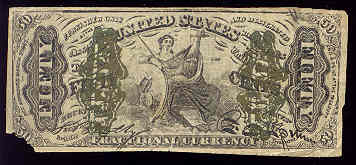
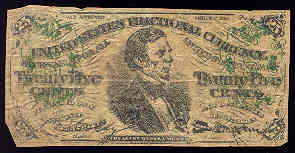
In the third issue, the 25C Fessenden, 50C Spinner and the 50C Justice notes were all copied and counterfeited. No counterfeits of the lesser denominations have been identified. There are at least eleven different varieties of the Fessenden, seventeen varieties of the Spinner notes and sixteen different Justice counterfeits.
Fourth and Fifth Issue CFT's
As soon as the Lincoln notes were issued in January 1870 through September 1873, good looking counterfeits soon showed up (five varieties). The same thing happened when the Stanton (fourteen varieties) and Dexter (eleven varieties) notes were issued. The counterfeiters were actively making their presence felt. The only fifth issue note that was counterfeited was the Walker note with only one variety identified. The Stanton counterfeit note shown does not have its red seal.
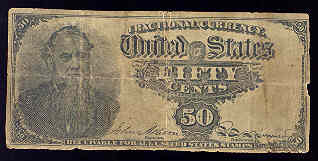
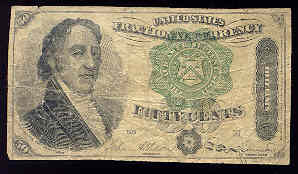
If it wasn't for all the counterfeit notes and the engravers who made them, we would not have all these wonderful varieties of the genuine fractional currency notes. Because of all the counterfeits, the Treasury tried to make it hard to duplicate the note with better inks, papers and other safety features that can now be seen in our current notes.
If you are interested in seeing other types of counterfeit currency and coins, click on the following link below which is a site dedicated to identification of counterfeit US coins and currency.
 All four denominations of the first issue postage currency were counterfeited. The paper used for the counterfeit notes appears to be thinner than the genuine notes. They had problems duplicating the reverse of these notes. The oval border surrounding the inscriptions in the genuine notes should have a series of distinct white dots in the center of the band. It should be so obvious to catch your eye. In the counterfeit, the band is dark and does not show the series of white dots. The portraits on the obverse of the spurious notes only crudely resemble their intended President. To help cover up the poor engravings of the portraits of some of the 25C notes, wax paper was placed over the obverse of the freshly inked paper to mute the engravings. The notes were also wrinkled and washed to make the note to appear to have been in circulation. Shown to the left are counterfeit examples of each of the denominations in the first issue. Please note the crude faces on each of the notes.
All four denominations of the first issue postage currency were counterfeited. The paper used for the counterfeit notes appears to be thinner than the genuine notes. They had problems duplicating the reverse of these notes. The oval border surrounding the inscriptions in the genuine notes should have a series of distinct white dots in the center of the band. It should be so obvious to catch your eye. In the counterfeit, the band is dark and does not show the series of white dots. The portraits on the obverse of the spurious notes only crudely resemble their intended President. To help cover up the poor engravings of the portraits of some of the 25C notes, wax paper was placed over the obverse of the freshly inked paper to mute the engravings. The notes were also wrinkled and washed to make the note to appear to have been in circulation. Shown to the left are counterfeit examples of each of the denominations in the first issue. Please note the crude faces on each of the notes.



